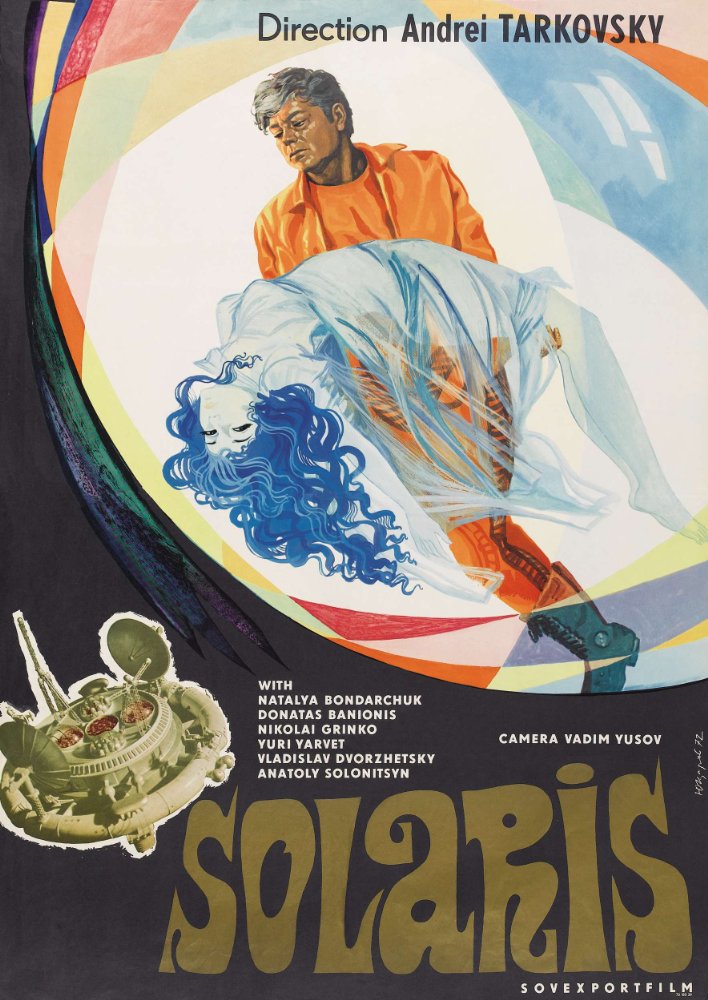Previous FilmSkeleton on Horseback
Next FilmSon of Flubber
Solaris 1971
 | A psychologist is sent to a station orbiting a distant planet in order to discover what has caused the crew to go insane. |
The Cast
| Natalya Bondarchuk | - | Khari |
| Donatas Banionis | - | Kris Kelvin, psikholog |
| Jüri Järvet | - | Doktor Snaut, kibernetik |
| Vladislav Dvorzhetskiy | - | Anri Berton, pilot |
| Nikolay Grinko | - | Nik Kelvin, otets Krisa Kelvina |
| Anatoliy Solonitsyn | - | Doktor Sartorius, astrobiolog |
| Olga Barnet | - | Mat Krisa Kelvina |
| Vitalik Kerdimun | - | Syn Anri Bertona |
Film Trivia
This was the most widely seen of Andrei Tarkovsky's films outside of the Soviet Union. However, Tarkovsky himself reportedly considered it the least favorite of the films he directed.
Stanislaw Lem was scathing of the adaptation of his novel, and complained that he did not write it about people's "erotic problems in space."
It is quite common to hear this movie compared to 2001: A Space Odyssey (1968). However, Andrei Tarkovsky had not seen that film before shooting 'Solaris'. When he did get round to seeing '2001', he criticised it for being "sterile".
While Solaris mostly doesn't concern itself with real-world technology and doesn't refer to it much, it does correctly predict two devices which did in fact become commonplace: home video recording and widescreen flat-panel TVs. Ironically, these are both shown in the pastoral first part of the film.
The extended scene following Berton as he rides back to the city was filmed in Osaka and Tokyo. Foreign travel was not easily approved, and the reason this long scene was left in the movie was probably to justify that trip for the director and crew.
There are a number of references to Cervantes' "Don Quixote" in the film. In the library, Snaut quotes from the novel ("Never before, Sancho, have I heard you speak so elegantly as now.") At one point, Dr Snaut also refers to tilting at windmills, and during the weightless scene, an open copy of Don Quixote flies past, showing the knight errant on his steed Rosinante.
Snaut mentions the legend of Martin Luther and the inkwell. Luther, who was the founder of the Protestant Reformation, is said to have thrown an inkwell at the Devil to drive him away, when he tried to annoy him in the night. This may, in fact, be a simple misunderstanding. Although there is an ink stain on the wall of Luther's room at the Wartburg, the notion that he had "driven the Devil away with ink", may in fact refer to his German translation of the Bible, and his writings, and so to be taken metaphorically.
In Kris Kelvin's room, it is possible to see an icon painted by Andrei Rublev, the Russian painter who inspired Tarkovsky's Andrei Rublev (1966).
In addition to Pieter Bruegel the Elder's "Hunters in the Snow", the painting that is meditated on in the library, three more of his paintings can be seen displayed there during the weightless scene: "Landscape with the Fall of Icarus," "The Harvesters," and "The Gloomy Day, beginning of Spring."
In Lem's novel, Hari is spelt "Harey", an anagram of Rheya. This is probably a reference to the titan "Rhea", who was mother of the Gods in Greek mythology, and which is also the name of a moon of Saturn. Rhea was the wife of Cronus/Saturn (the ruler of time), and the sister of Oceanus (Solaris is an ocean planet) and Tethys, a sea goddess, as well as the mother of Poseidon/Neptune; her parents were Uranus (the sky god) and Gaia (the earth goddess).
A print was screened at the Cinema Village theater in New York City in the mid-1980s that combined an English-dubbed version of the film with sequences from a Russian-language print. This version also featured cheesy 1970s-era titles. Around this time, this was considered the most complete version of the film available in the United States. It was not until the re-opening of New York's Film Forum theatre in 1989 that the complete and uncut Russian-language version was shown there theatrically.
The painting in the library scene is "Hunters in the Snow" (1565) by the Flemish painter Pieter Brueg(h)el the Elder (c. 1525-69). It is now in the Kunsthistorisches Museum in Vienna.
A number of sources claimed that Soviet officials withheld the 165-minute version from export. Mosfilm did indeed issue this version for export, and subtitled prints were being shown in the United States in 1973.
Henri Berton's name may be a reference to André Breton (1896-1966), the leader and founder of the surrealist movement. His last name is an anagram of "Breton", and his first name "Henri" is a French forename.
The movie is based on the novel by Polish author Stanislaw Lem.
Two characters' names vary a great deal in the different versions of this story. The female character is known as "Rhea" in the novel, "Hari/Khari" in the subtitles and Russian dialogue, "Carrie" in the English dubbing, and "Rheya" in Steven Soderbergh's remake. The Doctor is known as "Snow" in the English translation of the novel and Soderbergh version, "Snaut" in the subtitles and Russian dialogue, and "Stroud/Strowd" in the English dub.
This is over an hour longer than the remake, Steven Soderbergh's Solaris (2002).
Included among the "1001 Movies You Must See Before You Die", edited by Steven Schneider.
The film is included on Roger Ebert's "Great Movies" list.
Ranked number 57 non-English-speaking film in the critics' poll conducted by the BBC in 2018.
This film is part of the Criterion Collection, spine #164.
When Kelvin reunites with his father at the end of the film and falls at his feet, the pose they assume is that of the father and son in Rembrandt's "The Prodigal Son."